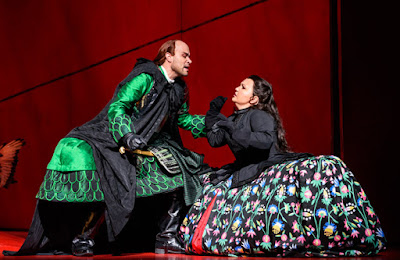James Karas
Twelfth Night is playing at
Shakespeare’s Globe Theatre in London this summer. It is directed by Emma Rice who
is also the Artistic Director of the theatre. Ms Rice should have had the
curtesy to warn people that what is on stage is not Shakespeare’s Twelfth Night but an adaptation. Carl
Grose is listed in the credits for “additional text and lyrics” and there are
numerous cuts in the text, a great deal of music and dancing has been added and
Shakespeare’s play has been dumbed down for a teenage audience. The warning
should have concluded with the advice that Shakespeare lovers or people who
respect the text should stay away.
I went to see Shakespeare’s play
and not an adaptation for teenagers.
Le Gateau Chocolat, centre, as
Feste and the cast on board in Twelfth Night. Photograph: Tristram
Kenton.
The play opens on board a ship (appropriate)
and a man in drag in a sequin dress with a grotesque wig starts singing. He has
an impressive bass voice but what we get is about ten minutes of unpleasant
noise. After the shipwreck near an island in northern Scotland in 1979 (we are
told this in the programme) Viola asks “what country, friends, is this?” and
everybody on stage answers “Illyria.” Are these the survivors of the wreck? Who
are they? One person takes over the dialogue and tells her that Illyria is
governed by Orsino and sure enough Orsino walks across the stage dancing and
singing “If music be the food of love.” He mentions Olivia and she saunters
across the stage. Welcome to Sesame Street.
The man in drag turns out to be
Feste, the clown (Le Gateau Chocolat) who will get rid of the wig but keep the
sequin dress. He will do a lot of singing and the rest of the cast will join in
frequently. There is a band and it is used to the point where I wanted to
scream “SHUT UP” especially when they played while characters were speaking.
Scene changes were effected with
dancing when the whole cast came on stage, did a few steps and ran off. This
was ridiculous, unnecessary and had no other effect than to keep the teenagers
amused.
If Rice did not try so hard for
the ridiculous, it could have been a good production. Anita-Joy Uwajeh made a
spry and attractive Viola/Cesario as did John Pfumojena as her brother
Sebastian. Annette McLaughlin was fine as Olivia but she looks a bit past her
bloom of youth for the part. Joshua Lackey’s Orsino is a shallow, dancing and
singing playboy and not the moping, love-sick duke.
Marc Antolin (Sir Andrew Aguecheek), Carly
Bawden (Maria) and Tony Jayawardena (Sir Toby Belch).
Photograph: Tristram
Kenton
Katy Owen made an interesting
Malvolio. She is a petite woman with an elastic body who can kick her heels
above her head. She is a very feisty Malvolio and in a normal production would
have been superb.
Marc Antolin’s Sir Andrew is
played like the old caricature of an effeminate man in a pink sweater and Tony
Jayawardena’s golfing Sir Toby gets the laughs
when they play Shakespeare.
In other words, Shakespeare
managed to break through despite the countless alterations, additions,
subtractions, dumbing down and garbage brought in by Rice and Grose. By the end
of the performance I was so infuriated that the only word I could come with
when asked my opinion was excrement.
__________
Twelfth Night by William Shakespeare plays in
repertory until August 5, 2017 at Shakespeare’s Globe Theatre, 21 New Globe
Walk, London. www.shakespearesglobe.com



















